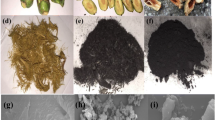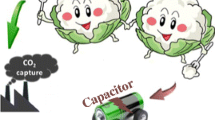Abstract
Biomass-derived porous carbons have been considered as the most potential candidate for effective CO2 adsorbent thanks to being widely-available precursor and having highly porous structure and stable chemical/physical features. However, the biomass-derived porous carbons still suffer from the poor optimization process in terms of the synthesis conditions. Herein, we have successfully fabricated coconut shell-derived porous carbon by a simple one-step synthesis process. The as-prepared carbon exhibits advanced textual activity together with well-designed micropore morphology and possesses oxygen-containing functional groups (reached 18.81 wt %) within the carbon matrix. Depending on the different activating temperatures (from 700 to 800 °C) and KOH/biomass mass ratios (from 0.3 to 1), the 750 °C and 0.5 mass ratio were found to be enabling the highest CO2 capture performance. The optimal adsorbent was achieved a high CO2 uptake capacity of 5.92 and 4.15 mmol·g−1 at 0 and 25 °C (1 bar), respectively. More importantly, as-prepared carbon adsorbent exhibited moderate isosteric heat of adsorption and high CO2/N2 selectivity. The results were revealed not only the textural feature but also the surface functional groups critically determine the CO2 capture performance, indicating coconut shell-derived porous carbon has a considerable potential as a solid-state adsorbent for the CO2 capture.

Similar content being viewed by others
References
Ma C, Lu T, Shao J, Huang J, Hu X, Wang L. Biomass derived nitrogen and sulfur co-doped porous carbons for efficient CO2 adsorption. Separation and Purification Technology, 2022, 281: 119899
Ratajczak P, Suss M E, Kaasik F, Beguin F. Carbon electrodes for capacitive technologies. Energy Storage Materials, 2019, 16: 126–145
Wang Y F, Zou S J, Hu W P, Wu F F, Yang J X, Cen Y Y, Yang D X, Hou Z Q, Huang K J. Biomass-derived graphene-like carbon nanoflakes for advanced supercapacitor and hydrogen evolution reaction. Journal of Alloys and Compounds, 2022, 928: 167176
Gao W R, Lin Z X, Chen H R, Yan S S, Huang Y, Hu X, Zhang S. A review on N-doped biochar for enhanced water treatment and emerging applications. Fuel Processing Technology, 2022, 237:107468
He L, Weniger F, Neumann H, Beller M. Synthesis, characterization, and application of metal nanoparticles supported on nitrogen-doped carbon: catalysis beyond electrochemistry. Angewandte Chemie International Edition, 2016, 55(41): 12582–12594
Das O, Bhattacharyya D, Hui D, Lau K T. Mechanical and flammability characterisations of biochar/polypropylene biocomposites. Composites Part B: Engineering, 2016, 106: 120–128
Idrees M, Jeelani S, Rangari V. Three-dimensional-printed sustainable biochar-recycled PET composites. ACS Sustainable Chemistry & Engineering, 2018, 6(11): 13940–13948
Li S Y, Li X Y, Chen C C, Wang H Y, Deng Q Y, Gong M, Li D G. Development of electrically conductive nano bamboo charcoal/ultra-high molecular weight polyethylene composites with a segregated network. Composites Science and Technology, 2016, 132: 31–37
Shi S, Liu Y. Nitrogen-doped activated carbons derived from microalgae pyrolysis byproducts by microwave/KOH activation for CO2 adsorption. Fuel, 2021, 306: 121762
Shen S, Shi X, Li C, Guo H, Long Q, Wang S, Yin X. Nonaqueous (amine + glycol ether) solvents for energy-efficient CO2 capture: new insights into phase change behaviors and assessment of capture performance. Separation and Purification Technology, 2022, 300: 121908
Millward A R, Yaghi O M. Metal-organic frameworks with exceptionally high capacity for storage of carbon dioxide at room temperature. Journal of the American Chemical Society, 2005, 127(51): 17998–17999
Chatterjee S, Jeevanandham S, Mukherjee M, Vo D V N, Mishra V. Significance of re-engineered zeolites in climate mitigation—a review for carbon capture and separation. Journal of Environmental Chemical Engineering, 2021, 9(5): 105957
Sun L B, Kang Y H, Shi Y Q, Jiang Y, Liu X Q. Highly selective capture of the greenhouse gas CO2 in polymers. ACS Sustainable Chemistry & Engineering, 2015, 3(12): 3077–3085
Sang Y, Cao Y, Wang L, Yan W, Chen T, Huang J, Liu Y N. N-rich porous organic polymers based on Schiff base reaction for CO2 capture and mercury(II) adsorption. Journal of Colloid and Interface Science, 2021, 587: 121–130
Yan H Y, Zhang G J, Xu Y, Zhang Q Q, Liu J, Li G Q, Zhao Y Q, Wang Y, Zhang Y F. High CO2 adsorption on amine-functionalized improved macro-/mesoporous multimodal pore silica. Fuel, 2022, 315: 123195
Zhang G, Zhao P, Hao L, Xu Y, Cheng H. A novel amine double functionalized adsorbent for carbon dioxide capture using original mesoporous silica molecular sieves as support. Separation and Purification Technology, 2019, 209: 516–527
Wang Y, Kang C, Zhang Z, Usadi A K, Calabro D C, Baugh L S, Di Yuan Y, Zhao D. Evaluation of Schif-base covalent organic frameworks for CO2 capture: structure-performance relationships, stability, and performance under wet conditions. ACS Sustainable Chemistry & Engineering, 2022, 1(10): 332–341
Wang J, Zhang P, Liu L, Zhang Y, Yang J, Zeng Z, Deng S. Controllable synthesis of bifunctional porous carbon for efficient gas-mixture separation and high-performance supercapacitor. Chemical Engineering Journal, 2018, 348: 57–66
Shao J, Ma C, Zhao J, Wang L, Hu X. Effective nitrogen and sulfur co-doped porous carbonaceous CO2 adsorbents derived from amino acid. Colloids and Surfaces A: Physicochemical and Engineering Aspects, 2022, 632: 127750
Huang J, Bai J, Demir M, Hu X, Jiang Z, Wang L. Efficient N-doped porous carbonaceous CO2 adsorbents derived from commercial urea-formaldehyde resin. Energy & Fuels, 2022, 36(11): 5825–5832
Qie Z P, Wang L J, Sun F, Xiang H, Wang H, Gao J H, Zhao G B, Fan X L. Tuning porosity of coal-derived activated carbons for CO2 adsorption. Frontiers of Chemical Science and Engineering, 2022, 16(9): 1345–1354
Wang Y X, Hu X D, Guo T, Hao J, Si C D, Guo Q J. Efficient CO2 adsorption and mechanism on nitrogen-doped porous carbons. Frontiers of Chemical Science and Engineering, 2021, 15(3): 493–504
Wang H, Wang H, Liu G, Yan Q. In-situ pyrolysis of Taihu blue algae biomass as appealing porous carbon adsorbent for CO2 capture: role of the intrinsic N. Science of the Total Environment, 2021, 771: 145424
Ma C, Bai J, Demir M, Hu X, Liu S, Wang L. Water chestnut shell-derived N/S-doped porous carbons and their applications in CO2 adsorption and supercapacitor. Fuel, 2022, 326: 125119
Guo L, Yang J, Hu G, Hu X, Wang L, Dong Y, DaCosta H, Fan M. Role of hydrogen peroxide preoxidizing on CO2 adsorption of nitrogen-doped carbons produced from coconut shell. ACS Sustainable Chemistry & Engineering, 2016, 4(5): 2806–2813
Tsai W T, Jiang T J. Mesoporous activated carbon produced from coconut shell using a single-step physical activation process. Biomass Conversion and Biorefinery, 2018, 8(3): 711–718
Mi J, Wang X R, Fan R J, Qu W H, Li W C. Coconut-shell-based porous carbons with a tunable micro/mesopore ratio for high-performance supercapacitors. Energy & Fuels, 2012, 26(8): 5321–5329
Lin T, Chen W, Wang L L. Particle properties in granular activated carbon filter during drinking water treatment. Journal of Environmental Sciences (China), 2010, 22(5): 681–688
Yorgun S, Yildiz D. Preparation and characterization of activated carbons from Paulownia wood by chemical activation with H3PO4. Journal of the Taiwan Institute of Chemical Engineers, 2015, 53: 122–131
Singh G, Ruban A M, Geng X, Vinu A. Recognizing the potential of K-salts, apart from KOH, for generating porous carbons using chemical activation. Chemical Engineering Journal, 2023, 451: 139045
Aghel B, Behaein S, Alobiad F. CO2 capture from biogas by biomass-based adsorbents: a review. Fuel, 2022, 328: 125276
Himeno S, Komatsu T, Fujita S. High-pressure adsorption equilibria of methane and carbon dioxide on several activated carbons. Journal of Chemical & Engineering Data, 2005, 50(2): 369–376
Ello A S, de Souza L K C, Trokourey A, Jaroniec M. Coconut shell-based microporous carbons for CO2 capture. Microporous and Mesoporous Materials, 2013, 180: 280–283
Vargas D P, Giraldo L, Silvestre-Albero J, Moreno-Pirajan J C. CO2 adsorption on binderless activated carbon monoliths. Adsorption, 2011, 17(3): 497–504
Prauchner M J, Oliveira S D, Rodriguez-Reinoso F. Tailoring low-cost granular activated carbons intended for CO2 adsorption. Frontiers in Chemistry, 2020, 8: 581133
Yang J, Yue L, Hu X, Wang L, Zhao Y, Lin Y, Sun Y, DaCosta H, Guo L. Efficient CO2 capture by porous carbons derived from coconut shell. Energy & Fuels, 2017, 31(4): 4287–4293
Li D W, Wang Y, Zhang X X, Zhou J J, Yang Y H, Zhang Z B, Wei L, Tian Y Y, Zhao X B. Effects of compacting activated carbons on their volumetric CO2 adsorption performance. Fuel, 2020, 262: 116540
Liu Y Z, Wang H, Li C C, Wang S H, Li L, Song C W, Wang T H. Hierarchical flaky porous carbon derived from waste polyimide film for high-performance aqueous supercapacitor electrodes. International Journal of Energy Research, 2022, 46(1): 370–382
Wang D B, Geng Z, Li B, Zhang C M. High performance electrode materials for electric double-layer capacitors based on biomass-derived activated carbons. Electrochimica Acta, 2015, 173: 377–384
Subramanian N, Viswanathan B. Nitrogen- and oxygen-containing activated carbons from sucrose for electrochemical supercapacitor applications. RSC Advances, 2015, 5(77): 63000–63011
Lu T, Ma C, Demir M, Yu Q, Aghamohammadi P, Wang L, Hu X. One-pot synthesis of potassium benzoate-derived porous carbon for CO2 capture and supercapacitor application. Separation and Purification Technology, 2022, 301: 122053
Sevilla M, Fuertes A B. Sustainable porous carbons with a superior performance for CO2 capture. Energy & Environmental Science, 2011, 4(5): 1765–1771
Ma X C, Yang Y H, Wu Q D, Liu B G, Li D P, Chen R F, Wang C H, Li H L, Zeng Z, Li L Q. Underlying mechanism of CO2 uptake onto biomass-based porous carbons: do adsorbents capture CO2 chiefly through narrow micropores? Fuel, 2020, 282: 282
Sui Z Y, Cui Y, Zhu J H, Han B H. Preparation of three-dimensional graphene oxide-polyethylenimine porous materials as dye and gas adsorbents. ACS Applied Materials & Interfaces, 2013, 5(18): 9172–9179
Furukawa H, Yaghi O M. Storage of hydrogen, methane, and carbon dioxide in highly porous covalent organic frameworks for clean energy applications. Journal of the American Chemical Society, 2009, 131(25): 8875–8883
Ben T, Li Y, Zhu L, Zhang D, Cao D, Xiang Z, Yao X, Qiu S. Selective adsorption of carbon dioxide by carbonized porous aromatic framework (PAF). Energy & Environmental Science, 2012, 5(8): 8370–8376
Zhang Y, Wei Z Q, Liu X, Liu F, Yan Z H, Zhou S Y, Wang J, Deng S G. Synthesis of palm sheath derived-porous carbon for selective CO2 adsorption. RSC Advances, 2022, 12(14): 8592–8599
Yang Z X, Guo X F, Zhang G J, Xu Y. One-pot synthesis of high N-doped porous carbons derived from a N-rich oil palm biomass residue in low temperature for CO2 capture. International Journal of Energy Research, 2020, 44(6): 4875–4887
Lu T, Bai J, Demir M, Hu X, Huang J, Wang L. Synthesis of potassium Bitartrate-derived porous carbon via a facile and Self-Activating strategy for CO2 adsorption application. Separation and Purification Technology, 2022, 296: 121368
Ma C, Bai J, Hu X, Jiang Z, Wang L. Nitrogen-doped porous carbons from polyacrylonitrile fiber as effective CO2 adsorbents. Journal of Environmental Sciences (China), 2023, 125: 533–543
Acknowledgements
Financial support was provided by Zhejiang Provincial Natural Science Foundation (Grant No. LY21B070005), National Undergraduate Training Program for Innovation and Entrepreneurship of China and Self designed scientific research project of Zhejiang Normal University (Grant No. 2021ZS06). Demir M would like to acknowledge financial support from TUBITAK 2247 with a project number of 121C217 and Gaziantep KOSGEB.
Author information
Authors and Affiliations
Corresponding authors
Supplementary materials
Rights and permissions
About this article
Cite this article
Bai, J., Huang, J., Yu, Q. et al. Fabrication of coconut shell-derived porous carbons for CO2 adsorption application. Front. Chem. Sci. Eng. 17, 1122–1130 (2023). https://doi.org/10.1007/s11705-022-2292-6
Received:
Accepted:
Published:
Issue Date:
DOI: https://doi.org/10.1007/s11705-022-2292-6




